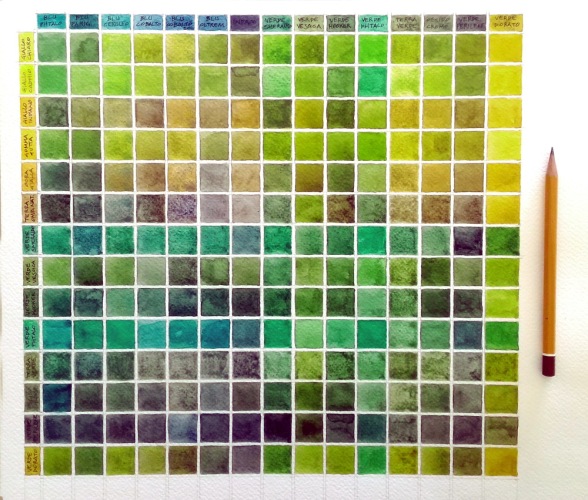
“Two hundred and ten Shades of Green” (2016), Watercolour on paper (300 g/m²-140 lbs), 35x36cm.


“Two hundred and ten Shades of Green” (2016), Watercolour on paper (300 g/m²-140 lbs), 35x36cm.
 What do Star Wars and Indiana Jones have in common?
What do Star Wars and Indiana Jones have in common? 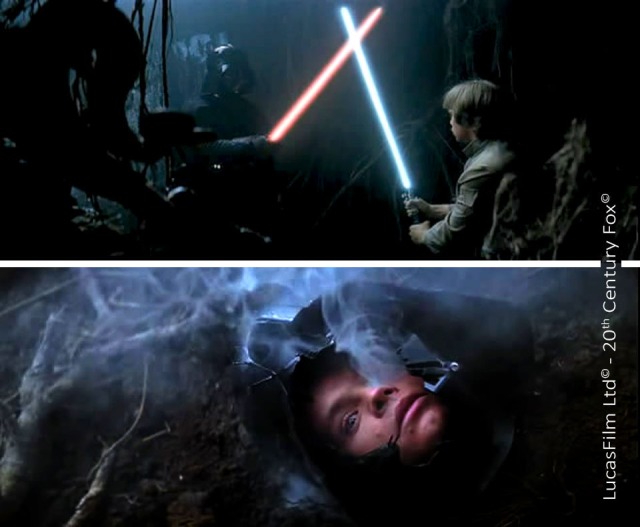 This other scene is very famous: Leila, Solo and Chewbacca are trapped in Cloud City. Luke arrives and engages a duel with Vader. At first. the Sith strives little, trying to get with words the youngman to pass to the Dark Side of the Force; then, because the refusal of him, he start pulling slashes, cutting off the Luke’s right hand. While this is clinging above the air duct of the city, Vader settles the coup de grace, revealing him to be his father.
This other scene is very famous: Leila, Solo and Chewbacca are trapped in Cloud City. Luke arrives and engages a duel with Vader. At first. the Sith strives little, trying to get with words the youngman to pass to the Dark Side of the Force; then, because the refusal of him, he start pulling slashes, cutting off the Luke’s right hand. While this is clinging above the air duct of the city, Vader settles the coup de grace, revealing him to be his father.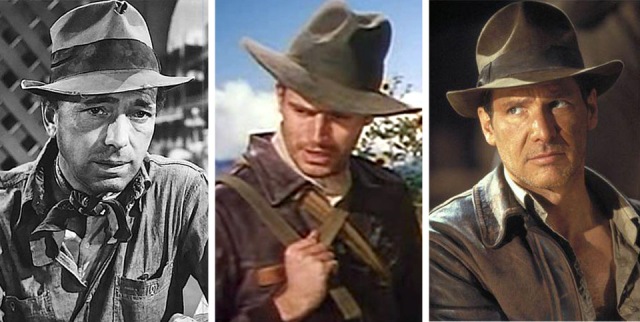 It’s not surprising to note that, in front of the unavailability of Tom Selleck to play the role, because his contract for Magnum, PI, this has been given to Harrison Ford, because apparently it is still in a tough guy, a buster, as they had been Bob Falfa and Han Solo. But Indiana Jones is a more complex character. He’s a person with two souls (as Clark Kent/Superman): on the one hand, the university professor of archeology, on the other, the adventurous explorer relics-hunter. If the first is what his father wanted him to become (repeating his choices), the second embodies the dreams of teenage Henry Jones Jr., who, not surprisingly, has chosen the battle name Indiana , namely that of the dog he had as a boy. Thus, even if the character of the Father only appears in the third movie, his shadow hangs in fact from the beginning of the saga.
It’s not surprising to note that, in front of the unavailability of Tom Selleck to play the role, because his contract for Magnum, PI, this has been given to Harrison Ford, because apparently it is still in a tough guy, a buster, as they had been Bob Falfa and Han Solo. But Indiana Jones is a more complex character. He’s a person with two souls (as Clark Kent/Superman): on the one hand, the university professor of archeology, on the other, the adventurous explorer relics-hunter. If the first is what his father wanted him to become (repeating his choices), the second embodies the dreams of teenage Henry Jones Jr., who, not surprisingly, has chosen the battle name Indiana , namely that of the dog he had as a boy. Thus, even if the character of the Father only appears in the third movie, his shadow hangs in fact from the beginning of the saga.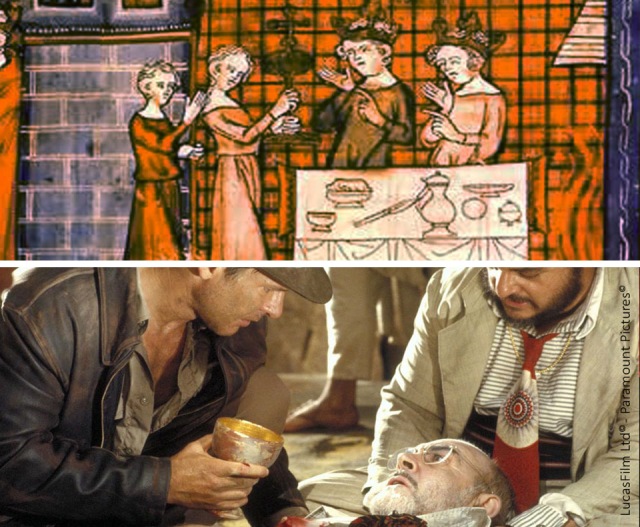 It’s not the only time Indiana performs such acts: in the Raiders of the Lost Ark, he warns Marion to don’t look at the opening of the Ark; in The Temple of Doom, he invokes the power of the Shiva’s stones. Paradoxically, he is both a robber of tombs and a devout of the cults he profanes. The gesture of the Grail is also a recognition of the sanctity of the King/Father and the values in which he believes. This is the fate of the rebellious sons too, to inherit some of their parents’ values: Lucas himself, the son of a conservative, declared in 1997 that he is very conservative too.
It’s not the only time Indiana performs such acts: in the Raiders of the Lost Ark, he warns Marion to don’t look at the opening of the Ark; in The Temple of Doom, he invokes the power of the Shiva’s stones. Paradoxically, he is both a robber of tombs and a devout of the cults he profanes. The gesture of the Grail is also a recognition of the sanctity of the King/Father and the values in which he believes. This is the fate of the rebellious sons too, to inherit some of their parents’ values: Lucas himself, the son of a conservative, declared in 1997 that he is very conservative too.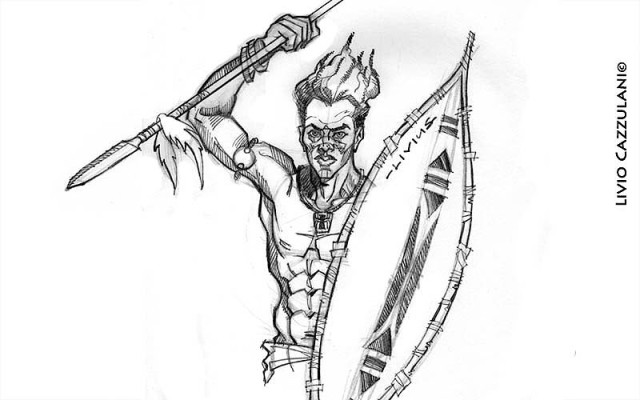
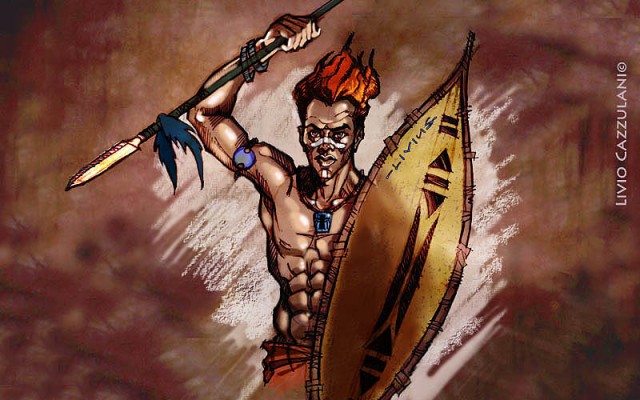 My illustration for my African fantasy novel: I Am Thunder, that you can read for free on-line on 20lines.
My illustration for my African fantasy novel: I Am Thunder, that you can read for free on-line on 20lines.
http://it.20lines.com/write/27814/io-sono-tuono
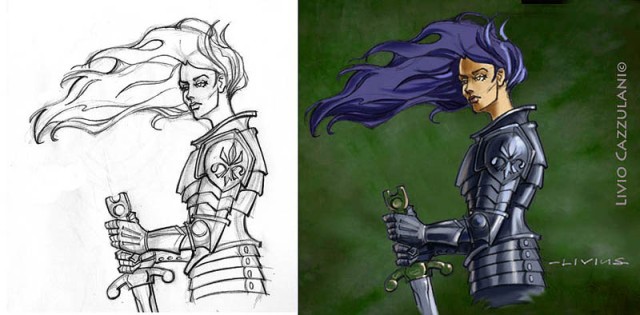 My illustration for my medieval fantasy novel in two parts: The Last Countess of Kaladhar, that you can read for free on-line on 20lines.
My illustration for my medieval fantasy novel in two parts: The Last Countess of Kaladhar, that you can read for free on-line on 20lines.
http://it.20lines.com/write/26995/lultima-contessa-di-kaladhar
http://it.20lines.com/write/27008/lultima-contessa-di-kaladhar-2
The WordPress.com stats helper monkeys prepared a 2013 annual report for this blog.
Here’s an excerpt:
A New York City subway train holds 1,200 people. This blog was viewed about 5,800 times in 2013. If it were a NYC subway train, it would take about 5 trips to carry that many people.
Bear Run (Pennsylvania) was a mild waterfall, until Frank Lloyd Wright there built above the finest house in the world: Fallingwater.
This gallery contains 2 photos.
“ Gott ist im Detail ” that’s “God is in the Detail”, is a sentence attributed to the German architect Ludwig Mies van der Rohe. The designer of the Seagram Building in New York, the Crown Hall at the IIT … Continue reading
It may seem strange to you, but the Veronese Green, the Verona Green and the Viridian are not the same colour.
To the late-Renaissance painter called Paolo il Veronese, to be born in that city, is related one of the colours most misunderstood by websites and some fine arts catalogs.
So, I try to clarify.
He born Paolo Caliari on 1528. The nickname was given to him in Venice, to mean he came from outside. When he was thirteen his father, a stonecutter, sent him to work by the painter Antonio Badile, but Veronese was so capable that three years later he went to work on his own.
After he had been in Parma, he painted the frescoes of the Duomo of Mantua, then he went to Venice, where he performed works in the Palazzo Ducale: the fresco in the Sala dei Consiglio dei Dieci and in the Sala dei Tre Capi del Consiglio. Also he collaborated on the decoration of the ceiling of the Biblioteca Marciana (National Library of St. Mark’s) and executed many works in the church of San Sebastiano.
At that time Verona, which in the Past had lived in great splendor under the lordship of the della Scala family, was subject to Venice, which ensured his peace, both from external attacks, and by internal fighting among local families – one of these feuds, between the Montecchi and the Capuleti families, is the background of the Shakespeare’s Romeo and Juliet –.
In “La Serenissima”, Veronese made his career quickly: he being at ease with both the sacred and mythological subjects, he had assignments both from religious orders, and from most prestigious private clients, such as that for Villa Barbaro, near Treviso, designed by Andrea Palladio. Here, the artist gave vent to his own imagination, painting a series of beautiful frescoes, with many trompe-l’œil, so from doors painted on the walls entering characters and on a virtual balcony in a hall overlooks the lady of the house with her nurse.
From Titian, he had borrowed the technique of tonal variation of the colours, in the order to achieve a soft chiaroscuro and the juxtaposition of complementary colours, to allow these to exalt each other – for example, in some paintings, he matched the Reds to the Greens –.By Titian again and by the attendance of architects like Palladio, the fineness to emphasize the visual composition, through the inclusion of architectural elements painted. The result was a gentle Mannerist style, which had nothing to do with the brutality of Tintoretto.
A painting by Veronese where is clearly visible his use of complementary color harmony is the Cena nella Casa di Levi (The Feast in the House of Levi) of 1573. I and my wife saw it last year, visiting the Gallerie dell’Accademia in Venice. It’s a huge painting (5.55 x 12.80 mt), which occupies the whole end wall of a hall. Its visual composition is divided into three vertical bands, highlighted by three round arches, supported by Corinthian capitals. It stands out here the harmony of Reds and Greens, indeed it’s clear that, when Veronese wants to highlight a character dressed in red, stands next to it something green and vice versa.
In fact, the real subject of the painting is the Last Supper of Christ and it had been commissioned by the Dominican Order of the Saints John and Paul’s basilica. However, the painter’s personal approach to the sacred subject – by including non-biblical characters such as jesters, Landsknecht mercenaries, drunkards and dogs – cost him a convocation by the Tribunal of the Holy Office of the Inquisition. The Veronese’s justification:
“When inside a painting I still have space, I embellish it with figures invented by myself.” [1]
not convinced the ecclesiastical judges, who ordered that the painting was remade. The artist found a quicker solution: he changed the work title.
It was just that brightest and highest in chroma green present in this painting – visible in other works too, like La famiglia di Dario ai piedi di Alessandro (The Family of Darius before Alexander, 1565-1570) e La scelta tra Virtù e Vizio ( Honor et Virtus post Mortem floret, 1567) – to link itself to the name of Paolo Veronese, as to be still sold today, after four and a half centuries.
Anyway, this is strange for two reasons.
The first is he had not a preference for the green only but, like all Venetian painters, he used all the available pigments in Venice – an important commercial city in its time – such as the ultramarine, azurite, smalt, indigo, cochineal carmine lake, vermilion, lead red, lead-tin yellow, orpiment, realgar, copper resinate. An example of this, is the polychromatic Le Nozze di Cana (The Marriage at Cana) 1563, at Musée de Louvre.
The second is that, as we have already seen about the Van Dyke Brown, the colour called “Veronese Green” – in France, Vert Paul Véronèse – produced not before the eighteenth century, is not the green used by the painter.
Differently from the possibilities offered to the Art, since the second half of 1800’s, by the chemical industry of the Colour, in the Past the painters used only colours tested by Tradition. At the time of Veronese, the greens could be of mineral origin (such as malachite or green earths) or vegetable (such as the Sap Green) or former-chemicals (such as Verdigris and Copper Resinate).
As recalled by Philip Ball, in his book – already quoted in this blog – “Bright Earth”[2], the introduction of Oil Painting, changed the choice of pigments, because the oil had a refractive index different from that of the previous medium used – the egg yolk – , thus some of these resulted so transparent, as are not longer used, like the Malachite Green, or reinforced with Flake White, like the Verdigris. Still others, were made again high in saturation by layering with colours of the same shade.
And that would be the case of the Veronese Green too. Because it would not, as some people written, a colour invented or discovered by Veronese.
It was used by half of the fifteenth century and was not a Veronese’s discovery – microscopic tests on paintings have detected it was already known in fourteenth-century – which consisted of laying a coat of Copper Resinate, on a coat of Verdigris, Lead White and Lead-Tin Yellow; in its turn spread over an imprimitura (an undercoat) of Lead White[3].
But what are these pigments?
Copper Resinate is a term that indicated a generic mix (the doses were not determined) of green salts of Copper,Venice turpentine and wax.
Verdigris is semi-transparent green in use since the Ancient Egyptians age – despite the name, from Old French vertegrez, that’s Green of Greece–. Because only in the Middle Ages, thanks to the Arab alchemists, were available strong acids like sulfuric and nitric acid, in the ancient times, the most acidic substance used was the vinegar. So, to take advantage of the bluish green properties of tarnished copper, strips of this metal were put into the vinegar to corrode.
Verdigris was mainly used for background landscapes. Much appreciated for its bluish shade, it fell out of use since the nineteenth century because, like all Copper pigments, over time darkened becoming brown. Anyway, its major defect was its toxicity. Defect that was increased by combining it with Lead White and that was enhanced in the eighteenth century when the Swedish Scheele combined it with Arsenic, achieving the Cooper-acetoarsenite (Scheele’s Green). In 1814, the German Sattler improved the compound, creating the more toxic Schweinfurter Grün, that’s the Emerald Green.
Just a Cooper-acetoarsenite compound is the “Veronese Green”, put on sale only two centuries after the death of the painter. However this is a improper use of his name: indeed, the concept of many colours whose name was joined to a famous painter, is to sell in a single tube, something reproducing the effect obtained by the artists only through several steps – an exception is International Klein Blue, which was created and patented by Klein himself, with collaboration of the paint manufacturer Edouard Adam –.
Therefore, the original Veronese Green, not only is not the equivalent of Emerald Green, but nor of Viridian– despite what mistakenly says the Italian page of Wikipedia.it – because the latter is made of Chromium oxide dihydrate and, in the fourteenth century, the chrome was not even discovered.
The history of Chromium pigments is well described by Philip Ball [4]. In 1797, the French chemist Vauquelin – who had already discovered the Beryllium – began to examine a Siberian red crystal, discovered thirty-six years earlier by the geologist Lehmann: the Crocoite. In this mineral, from which was extracted a red pigment for paints, Vauquelin discovered a new element, which produced highly coloured compounds, so he named the element Chromium – from Greek: Chroma, i.e. “Colour” –. In 1809, trying to synthesize in the laboratory the crocoite (lead chromate), instead of getting a red pigment, he produced a bright yellow – Chrome Yellow –. He realized that, by varying the temperature of the process, you could get bright pigments ranging from light to deep yellow, orange, red.
Although beautiful, these pigments were extremely expensive, because the only known deposit of chromium was in Siberia. Only later, they were more localized in the Shetland Islands and the United States.
About the green colour derived from Chromium, already in 1809, Vauquelin had written it was possible to obtain a green pigment from Crocoite, which could be used as a glaze for pottery. But, being rather dull, it not met with great interest. In 1838, however, the French Pannetier, hydrating the Chromium Oxide, got a deep and intense green, which in France was called Vert Émeraude. In England, anyway, already existed Emerald Green, which we mentioned above, thus that colour became known around 1860 as Viridian – from Latin Viridis, that’s “Green”–. The colour of Pannetier, although it liked, it was too expensive. Almost twenty years later, the chemical Guignet devised a different system for its production, which made it cheaper: the Vert Guignet (Guignet’s Green ) then became a very popular colour among the Impressionists.
It’s thus evident the Viridian has nothing to do with the Veronese Green.
Finally, Veronese Green should not be confused with Verona Green (or Verona Green Earth), which is a green earth – that’s a mix of Iron hydrosilicates with salts of Magnesium, Aluminum, Potassium – extracted, certainly not in that city, but in his province. Any reference to Paolo Veronese is purely coincidental.
This historic pigment was used in the Past, in the words of the Libro dell’Arte by Cennino Cennini – Italian painter born in the XV century, custodian of the medieval painting techniques dating from Giotto – into one of two possible recipes to perform the technique of verdaccio. This was an underpainting grisaille for the skin’s chiaroscuro, over which were applied successive layers of Red or Pink: in this way, were achieved gray shadows and avoided a too red complexion. The greenish hue of some character faces of medieval frescoes, reveals the use of this technique.

Verona Green(Verona Green Earth), Iron hydrosilicates with Magnesium, Aluminum, Potassium salts, ColorIndexName: PG 23
This problem was never involved works by Paolo Veronese: the perfect and delicate complexion of his characters, made it acceptable even the most daring subjects, such as the loving encounters between Venus and Mars (or Adonis), many times portrayed by him.
A curious age, that of la Serenissima: in which the Sacred and the Profane lived side by side; an intellectual class having as its ideal the humanistic culture, lived under the government of a lord with religious authority – the Doge –; finally, it was possible represent also the Lust, in a painting of mythological subject, but if you missed a reference in a sacred picture, you risked a process by the Inquisition.
This gallery contains 1 photo.
Until one day, Monsieur Giraud smiling said: “au revoir”, “goodbye”. Then he turned on the other side of the Moebius’ stRIP.
 Frédéric Chopin and Eugène Delacroix were friends.
Frédéric Chopin and Eugène Delacroix were friends.

left: E.Delacroix, Frédéric Chopin (1838), Musée du Louvre, Paris; right: E.Delacroix, Autoportrait au gilet vert (1837) Musée du Louvre, Paris